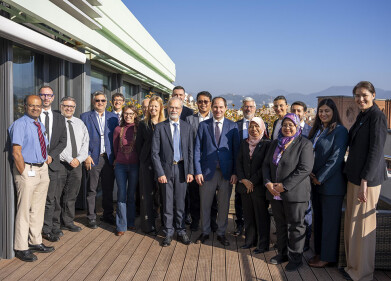Air clean up
Wearing Clothes Could Clean the Air
Oct 10 2012
Within just two years, we could all be wearing clothes that purify the air as we simply move around in them.
Plans are now proceeding to commercialise a revolutionary liquid laundry additive called ‘CatClo’, which contains microscopic pollution-eating particles.
The new additive is the result of collaboration between the University of Sheffield and London College of Fashion, with initial support from the Engineering and Physical Sciences Research Council (EPSRC, UK).
Items of clothing only need to be washed in the additive once, as the nanoparticles of titanium dioxide grip onto fabrics very tightly. When the particles then come into contact with nitrogen oxides in the air, they react with these pollutants and oxidise them in the fabric.
The nitrogen oxides treated in this way are completely odourless and colourless and pose no pollution hazard as they are removed harmlessly when the item of clothing is next washed, if they haven’t already been dissipated harmlessly in sweat. The additive itself is also completely harmless and the nanoparticles are unnoticeable from the wearer’s point of view.
One person wearing clothes treated with CatClo would be able to remove around 5g of nitrogen oxides from the air in the course of an average day – roughly equivalent to the amount produced each day by the average family car.
Nitrogen oxides produced by road vehicle exhausts are a major source of ground-level air pollution in towns and cities, aggravating asthma and other respiratory diseases. Asthma currently affects one in 12 adults and one in 11 children in the UK. As well as the general benefits that would result from people using CatClo, those suffering from respiratory conditions could also, by wearing clothes treated with the additive, give themselves cleaner air to breathe as they move around.
Professor Tony Ryan OBE of the University of Sheffield, who has co-led the project working closely with Professor Helen Storey MBE from London College of Fashion, says: “It’s the action of daylight on the nanoparticles that makes them function in this way. The development of the additive is just one of the advances we’re making in the field of photocatalytic materials – materials that, in the presence of light, catalyse chemical reactions. Through CatClo, we aim to turn clothes into a catalytic surface to purify air.”
“If thousands of people in a typical town used the additive, the result would be a significant improvement in local air quality”, says Professor Ryan. “This additive creates the potential for community action to deliver a real environmental benefit that could actually help to cut disease and save lives. In Sheffield, for instance, if everyone washed their clothes in the additive, there would be no pollution problem caused by nitrogen oxides at all.”
Professor Helen Storey, says: “When Science and Culture work together in this way, it becomes possible to involve the intended end user in the early stages of the development of the technology. This in itself is still a relatively new concept. **Through the making of a short viral film about CatClo, we were able to reach an audience of over 300 million people, from across 147 countries, engaging the public in the normally hidden research process. The direct feedback and enthusiasm we received revealed a massive market for this product from potential consumers who understand the concept behind it.”
“We’re now working closely with a manufacturer of environmentally friendly cleaning products to commercialise our laundry additive,” says Professor Ryan. “We believe that using the additive in a final rinse with a full washing load could potentially cost as little as 10 pence – a small price to pay for the knowledge that you’re doing something tangible to tackle air pollution and increase the life expectancy of people with respiratory conditions. We’re confident there’s a really big market out there for this product.”
Events
Carrefour des Gestions Locales de L'eau
Jan 22 2025 Rennes, France
Jan 29 2025 Tokyo, Japan
Feb 05 2025 Nantes, France
Feb 16 2025 Kampala, Uganda
Feb 26 2025 Chennai, India










